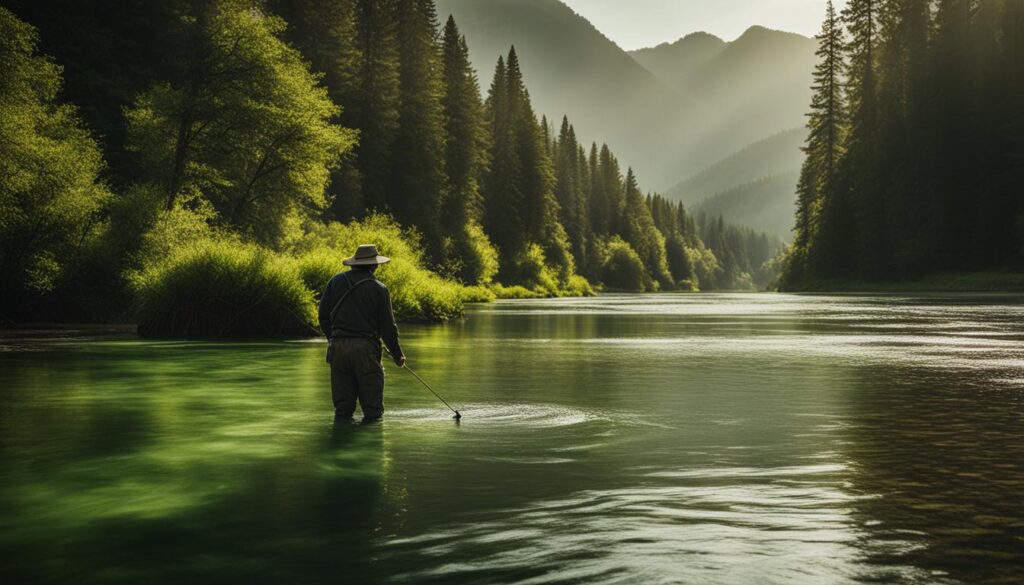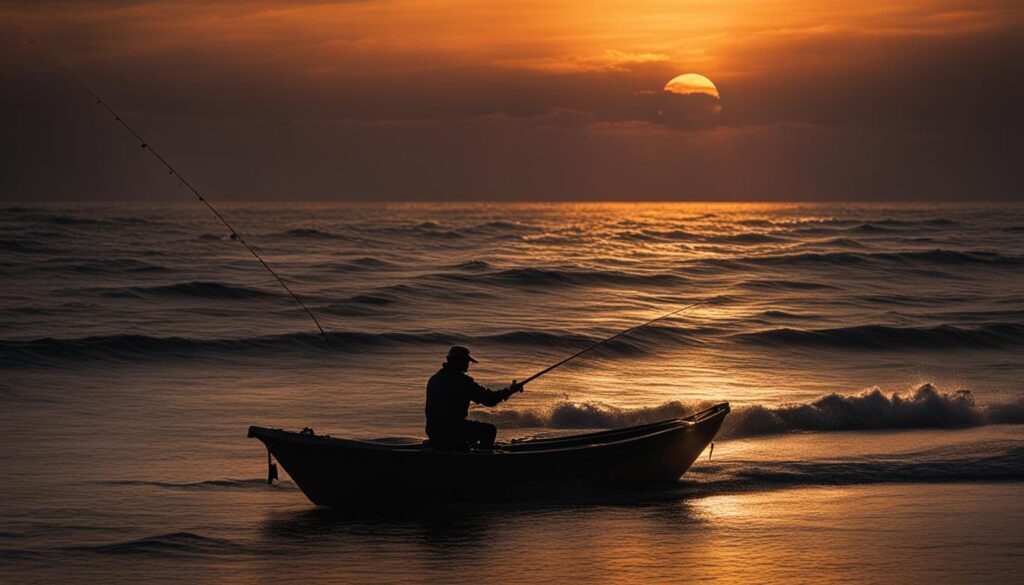We may earn money or products from the companies mentioned in this post.
Are you looking to up your fishing game and catch more fish? One technique you should consider mastering is trolling. Trolling for fish can be a highly effective way to catch a variety of species, but it requires a certain level of knowledge and skill.
In this comprehensive guide, we will provide you with the essential information you need to successfully troll for fish. We will cover fishing techniques, trolling tips, and the best trolling lures to use. Whether you are a beginner or an experienced angler, this guide will help you fine-tune your trolling skills and improve your chances of catching fish.
Key Takeaways
- Trolling is an effective way to catch fish
- Mastering trolling requires knowledge and skill
- This guide will cover essential fishing techniques, trolling tips, and the best trolling lures
- Readers will learn how to fine-tune their trolling setup and maximize their chances of catching fish
- Whether a beginner or an experienced angler, this guide will help improve trolling skills
Understanding Trolling for Fish
Trolling for fish is a popular and effective fishing technique that involves trailing lures or bait behind a moving boat to entice fish to bite. While trolling can be successful in both freshwater and saltwater environments, there are some differences in the techniques used.
Trolling for Freshwater Fish
In freshwater, trolling is typically done at slower speeds with lighter gear and smaller lures. Anglers often use downriggers or planer boards to help control the depth of their lures. Deep trolling techniques, such as using lead core line or heavy sinkers, can also be effective in deeper freshwater environments.
Trolling for Saltwater Fish
Saltwater trolling, on the other hand, often involves faster speeds, heavier gear, and larger lures. Anglers may use outriggers or downriggers to spread out multiple lines and cover more water. Deep trolling techniques can also be useful in saltwater environments, especially when targeting species like tuna or marlin.
Did You Know? Some anglers also use a trolling motor in combination with their main engine to help control the speed and direction of their boat while trolling.
Essential Equipment for Trolling
Trolling is all about maintaining the right depth and speed. The key to successful trolling is to have the right gear that will allow you to adjust your depth and speed accordingly. Here are some essential pieces of equipment you should have to ensure that you are trolling like a pro:
| Equipment | Purpose |
|---|---|
| Downriggers | Enables you to adjust the depth at which your lure is presented. |
| Trolling plates | Helps you maintain the right trolling speed and prevent your boat from going too fast. |
| Planer boards | Allows you to spread out your lines and cover more water. |
| Rod holders | Makes it easier to manage multiple lines and keep your lures at the right depth. |
Once you have the right equipment, the next step is to fine-tune your setup to achieve optimal results. Here’s what you need to know:
Trolling Speed
The speed at which you troll can have a significant impact on your success. The general rule of thumb is to troll at a speed that is between 2-5 mph, depending on the species of fish you are targeting. Some fish, like salmon, prefer slower speeds, while others, like tuna, prefer faster speeds.
To determine your trolling speed, invest in a speedometer or use a GPS to track your speed. Alternatively, you can use a trolling plate to help control your speed.
Trolling Depth
The depth at which you present your lure is just as important as your trolling speed. The depth at which a fish is feeding is influenced by water temperature, light penetration, and other factors. To determine the right depth, use a depth finder to locate where the fish are feeding and adjust your depth accordingly.
Remember, trolling is not an exact science, and it may take some trial and error to find the right depth and speed. Keep experimenting until you find the sweet spot that triggers a bite.
Choosing the Right Trolling Lures
Choosing the right trolling lures is essential for a successful fishing trip. With so many options available, it can be overwhelming for anglers to select the best trolling lures for their target fish species. In this section, we will explore the top trolling lures on the market and provide insights into effective trolling patterns.
Best Trolling Lures
| Lure Name | Fish Species | Features |
|---|---|---|
| Rapala X-Rap Magnum | Tuna, Wahoo, Mahi-Mahi | Deep-diving lip, rattles, holographic finish |
| Mann’s Stretch Series | King Mackerel, Striped Bass, Bluefish | Long, slender design, realistic baitfish finish |
| Berkley Gulp! Saltwater Swimming Mullet | Redfish, Trout, Flounder | Scented, lifelike action, durable |
These lures have proven to be highly effective in their respective fisheries and should be considered when selecting trolling lures. However, it’s important to note that selecting the right lure also depends on the size and color that matches the baitfish present in the waters being fished.
Trolling Patterns
Once the right lures have been selected, it’s essential to understand effective trolling patterns. A common technique is to troll in a zig-zag pattern, which creates a more natural presentation and helps cover a larger area of water. Another effective pattern is the “S” pattern, which mimics a wounded baitfish and entices predator fish to strike.
Pro Tip: Vary your trolling speed and depth to fine-tune your presentation and attract more fish.
By understanding the best lures to use and effective trolling patterns, anglers can increase their chances of catching their target fish species. Remember to adjust trolling speed and depth as needed and pay attention to the behavior of the fish to fine-tune your approach.
Techniques for Trolling Success
When it comes to trolling for fish, utilizing the right techniques can make all the difference in your success. Here are some of the top fishing techniques to take your trolling game to the next level:
Line Management
Proper line management is crucial for successful trolling. This includes keeping your lines tangle-free, adjusting the reel drag appropriately, and monitoring the line for any signs of a strike.
Rod Positioning
The position of your rod can affect the success of your trolling. One technique is to position the rod in a holder at a 90-degree angle from the boat, which allows for better contact with the lure and helps detect strikes more easily.
Bait Presentation Techniques
How you present your bait can also impact your trolling success. Consider varying your speed or changing the direction of your trolling pattern to trigger a strike. Additionally, adjusting the depth of your bait can increase your chances of attracting your target fish.
Using Planer Boards
Planer boards can be a useful tool for trolling. They allow for a wider spread of lures, which can increase your chances of attracting fish. Additionally, they can help keep your lines separated, reducing the risk of tangles.
Divers
Divers are another tool that can help you reach specific depths while trolling. By attaching a diver to your line, you can adjust the depth of your lure to target fish at different levels in the water column.
By utilizing these fishing techniques, you will be well on your way to mastering the art of trolling for fish.
Tips for Successful Trolling
Trolling for fish requires patience, attention to detail, and a willingness to adapt to changing conditions. Here are some essential trolling tips that can help you become a more successful angler:
- Location, location, location. One of the most critical factors in successful trolling is finding the right location. When trolling in open water, keep an eye out for changes in water temperature or current that may indicate the presence of fish. Look for underwater structures, such as drop-offs or weed beds, that may attract fish.
- Adjust your speed. The speed at which you troll can play a significant role in whether or not you catch fish. If you’re not having any luck, try adjusting your speed by either speeding up or slowing down your boat. Keep in mind that different fish species may prefer different trolling speeds.
- Experiment with bait presentation. The way you present your bait can also make a big difference in whether or not you catch fish. Try different bait colors, sizes, and shapes to see what works best. Consider using a trolling spreader bar or teaser to add some extra movement to your baits.
- Pay attention to the weather. Weather conditions can have a significant impact on trolling success. Overcast days with light wind can be ideal for trolling, while bright, sunny days may be less productive. Consider the time of day as well, with many fish species more active during dawn and dusk.
- Stay organized. Trolling can involve multiple lines and baits, making it important to stay organized. Use a spreader bar or outriggers to keep lines separated and prevent tangles. Consider using a planer board to spread out your lines and cover a wider area.
- Be patient. Trolling can be a slow and tedious process, but patience is key. Stay focused and alert, and be prepared to adjust your techniques as needed. Remember, catching a fish while trolling is often a matter of timing and persistence.
“Trolling can be one of the most effective fishing techniques available to anglers. With the right approach, attention to detail, and a little bit of luck, you can land some impressive fish while trolling.”
Trolling for Fish: Freshwater vs. Saltwater
As we’ve discussed, trolling techniques can differ depending on the environment you’re fishing in. When it comes to freshwater vs. saltwater trolling, there are some key differences to keep in mind.
Trolling for Freshwater Fish
Freshwater trolling is popular among anglers looking to catch species like salmon, trout, and walleye. These fish tend to be found in shallower waters, which means that trolling speeds are typically slower compared to saltwater trolling. Additionally, many freshwater anglers use downriggers to achieve the appropriate trolling depth, as this method allows for precise depth control.
Trolling for Saltwater Fish
When trolling in saltwater, anglers are often targeting larger species like tuna, marlin, and sailfish. These fish tend to be found in deeper waters, which means that trolling speeds are typically faster compared to freshwater trolling. Many saltwater anglers use planers or diving plugs to help get their lures deeper in the water column and reach the fish they’re targeting.
| Trolling Considerations | Freshwater | Saltwater |
|---|---|---|
| Trolling Speed | Slower speeds | Faster speeds |
| Trolling Depth | Shallower waters | Deeper waters |
| Trolling Equipment | Downriggers | Planers, diving plugs |
Regardless of whether you’re trolling in freshwater or saltwater, it’s important to choose the right trolling lure and employ effective fishing techniques. By mastering the art of trolling, you can increase your chances of landing your target species and enjoying a successful day on the water.
Conclusion
Mastering the art of trolling for fish can be a rewarding and fulfilling experience for any angler. By implementing the techniques, tips, and knowledge covered in this guide, you can enhance your fishing experiences and increase your chances of catching your target fish.
Remember to always choose the right trolling lures and fine-tune your trolling speed and depth for optimal results. Practice different fishing techniques like line management, rod positioning, and bait presentation to enhance your trolling success.
Additionally, take advantage of practical tips and tricks like locating productive fishing grounds, adjusting trolling speed based on environmental conditions, and understanding fish behavior. These insights can go a long way in improving your trolling skills and enhancing your overall fishing experiences.
Final Thoughts
Whether you’re trolling for freshwater fish or saltwater fish, this guide provides valuable information on how to troll effectively. Remember to always practice caution and safety when fishing, and respect the environment and those around you.
Thank you for reading this comprehensive guide on trolling for fish. We hope that you’ve gained valuable insights and knowledge to apply to your next fishing adventure. Happy trolling!
FAQ
What is trolling for fish?
Trolling for fish is a fishing technique that involves towing a fishing line behind a moving boat. This method allows anglers to cover a larger area and target fish that are actively swimming. It is commonly used to catch species like salmon, trout, walleye, and marlin.
What fishing techniques are used in trolling?
Trolling utilizes a variety of fishing techniques, including downrigging, planer board fishing, and surface trolling. Downrigging involves using a weight to keep the bait at a desired depth, while planer boards are used to spread out multiple lines. Surface trolling, on the other hand, involves fishing near the water’s surface using lures or baits.
What are the best trolling lures to use?
The best trolling lures to use depend on the type of fish you are targeting. Effective trolling lures include spoons, plugs, crankbaits, and flashers. It is recommended to have a variety of lures in different colors and sizes to increase your chances of attracting fish.
How do I determine the appropriate trolling speed?
The appropriate trolling speed varies depending on the species of fish you are targeting and the conditions of the water. As a general guideline, a speed between 2 to 4 miles per hour is commonly used for trolling. However, it is important to experiment and adjust your speed to find what works best for the specific fishing situation.
How can I fine-tune my trolling setup for optimal results?
To fine-tune your trolling setup, consider adjusting the trolling depth based on the fish species you are targeting. Use a depth finder or fishing chart to determine the depths at which certain fish species typically swim. Additionally, try experimenting with different lure colors, sizes, and patterns to see what attracts the most bites.
What are some tips for successful trolling?
Some tips for successful trolling include locating productive fishing grounds, adjusting trolling speed based on environmental conditions, and understanding fish behavior. It is also important to pay attention to rod positioning, line management, and bait presentation techniques. Practice and experience will help you refine your trolling skills.
Are there differences in trolling for fish in freshwater versus saltwater?
Yes, there are differences in trolling for fish in freshwater versus saltwater. The choice of lures, techniques, and the species of fish targeted can vary between the two environments. Freshwater trolling often focuses on species like trout and walleye, while saltwater trolling targets species like marlin and tuna.
Affiliate Disclosure: This post may contain affiliate links. If you purchase through our link, we may receive a small commission, but at no additional cost to you. For more information, please see our Disclosure statement.



